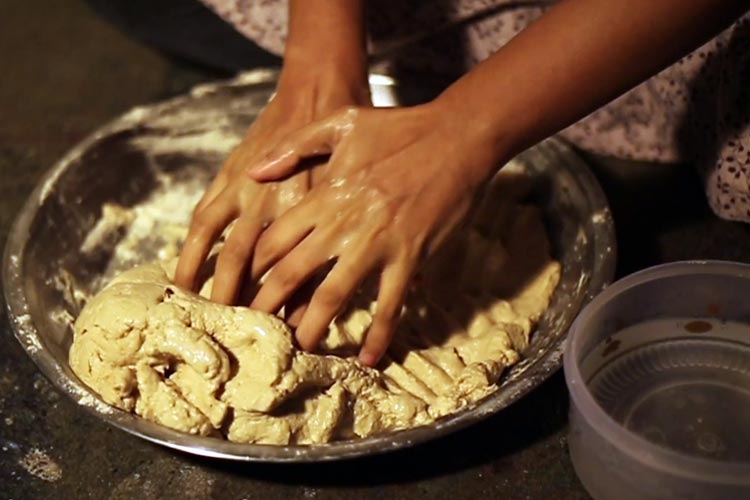Written by: Hamad Ali
Posted on: October 27, 2017 | 
Anwar Saeed's 'A Casual State of Being in a Soul Hunting Haven.' Displayed at Fomma Centre. (source: Omer Nabi)
Karachi Biennale 2017 (KB17), the most eclectic display of art the city has ever seen, was launched for the public on 21st October 2017. KB17 aims to engage at least 20% of the population of Karachi, introducing them to modern contemporary art from across Pakistan, and abroad. The Biennale’s theme, ‘Witness,’ will foster learning in the community through critical thinking about the city and its citizens, involve people in debates about history and erasures, and make them ponder over the politics of representation. KB17’s two-week long, free, public exhibitions feature installations, performative works and new media art.
The selected theme of ‘Witness’ appears to have resonated with over 140 artists from Europe, Americas, Africa, South and East Asia, and various parts of Pakistan. The works of internationally renowned artists like Shahzia Sikander, Richard Humann, Michelangelo Pistoletto, Yoko Ono, Miro Craemer, Bankleer, and Ruby Chishti, among others, are on display for people to experience art at its finest.
The chief curator of the Biennale, Amin Gulgee, says, “This has been an opportunity for me to learn and absorb diverse artists’ idiosyncratic vocabularies, from several continents. Visual artists are not the only ones involved; architects, filmmakers, photographers and professionals engaged with fashion and theatre, are also included. This cross-disciplinary approach reflects the ethos of Karachi.” Niilofur Farukkh, the CEO of the Biennale Trust believes KB17 will “draw art out of the gallery and into the spaces that express Karachi’s quotidian pulse.” Along with Gulgee, the curatorial team consists of Zarmeene Shah, Humayun Memon, Sarah Pagganwala, Zeerak Ahmed and Adam Fahy-Majeed.
The main venue for KB17, the 160-year-old NJV (Narayan Jagannath Vaidya) High School, which housed the first National Assembly of Pakistan, is situated in the heart of Karachi, on MA Jinnah Road. Other venues include Capri Cinema, Indus Valley School of Art and Architecture (IVS), Jamshed Memorial Hall, Karachi School of Art, 63 Commissariat Lines, Frere Hall, the VM Art Gallery, Pioneer Book House, Claremont House, Alliance Francaise and Fomma Trust. All exhibitions open to the public at 10 am and close at 6 pm.
A plethora of performances and art pieces are scheduled at different venues. While Rehan Bashir’s dance ‘Tribute to Nahid Siddiqui,’ as well as Jamal Shah’s interactive public art project, ‘Situation 101,’ have already taken place, pieces such as ‘Wit-ness’ by Quddus Mirza at Canvas Gallery and Wolfgang Spahn’s ‘Entropie’ at Frere Hall, can be caught in the upcoming days. Other performances which have occurred included Tazeen Qayyum’s ‘Unvoiced,’ Muhamad Ali’s ‘Elephant in the Room,’ and Farwa Hassan Rizvi’s ‘Unwan.’
Other prominent features of KB17 are the numerous installations. Artists like Ali Kazim, whose sculpture of human hair won the Mahvash and Jahangir Jury Art Prize at the opening of KB17, Arsalan Nasir, whose audio installation ‘Absent/Present’ is a composition of school-going children’s voices, and Syed Safdar, who has created a scaffolding of crutches, present thought provoking art. Site-specific art such as Sanki King’s transformation of Jamshed Memorial Hall’s rooftop, by inscribing the walls with his thoughts; Zahid Mayo’s calligraphy on trees and water tanks at IVS and 63 Commissariat; and Mahbub Jokhio’s brightly painted graves at NJV School, have transformed entire spaces into statements on the theme ‘Witness.’ The versatility of contemporary art can be seen in Aamir Habib’s ‘Already Eaten,’ which features a taxidermy donkey inserted with a television, Wardah Naeem Bukhari’s video which draws connections between the act of kneading dough and female sexuality, and Sharmeen Obaid Chinoy’s virtual reality short films, ‘Look but with Love.’ With works by prominent names like R.M. Naeem, Huma Mulji, Moeen Faruqi, Meher Afroz, Adeela Suleman and Sonya Battla, the biennale is attracting growing numbers of visitors each day.
Leading up to the Biennale, multiple events were held from 2015 – 2017, to spread art knowledge, and create interdisciplinary critical thinking among the public.

‘Reel on Hai’ was Pakistan’s most extensive public art program, conducted in collaboration with Pakistan Cables. 100 cable reels were transformed into works of art by local and international artists, and then installed at different public venues (parks, hospitals, roads) for Karachiites to witness and engage with.
The Discursive Roundtable Discussions were held four times, and aimed to produce knowledge about critical discourse through topics like, ‘Women’s Rights Movement as Witness’ and ‘Resisting Erasures: Art and Literature as Witness to a New Century.’
The Karachi Art Directory Project, conducted in June 2016, with collaborative partner VM Art Research Library, led to a list of basic information and contact details of all artists, curators, art critics, galleries and art educational institutions in the city, urban pop artists like hoarding painters, truck artists, digest artists, as well as traditional artists such as calligraphers. Student interns from art colleges were recruited to research the decade of 2006-2016, to generate this valuable data.
South-South Critical Study Group began in July 2017, with an aim to develop interaction between the various art scenes of the global South. In an effort to create connections within what Gerardo Mosquera calls ‘large zones of silence’ (countries separated by continents but connected by similar challenges), the group studied the works of artists, curators and critics of Latin America, to create a discourse on art of the global south. Study sessions and discussions were held on the works of Gerardo Mosquera, Carlos Aceroz Ruiz and Adriana Almada, who was able to attend the discussions herself. The notes generated through these sessions will be compiled and published under the auspices of KB17.
Public events such as poetry and book readings (Kalaam Sessions), Drum Circle, film screenings, dialogues and educational activities will also be a part of the biennale. KB17 will close at Frere Hall on November 5th, 2017.
Special thanks to Zahid Mayo, Omer Nabi, Linards Kulless, Rida Fatima and Rabia Saeed Akhtar for sharing their images of the Biennale with us.
You may also like: